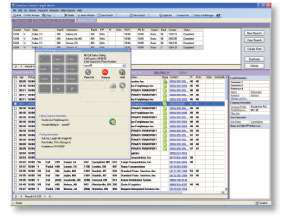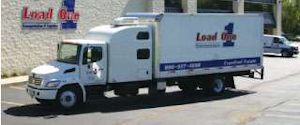Part III: Technology
5 ways carriers, shippers, brokers are using technology to speed up communications now and in the future
If shippers and brokers are planning to move a lot of loads soon, they’d better act now if they want a way to haul them.
By next summer, the culmination of several events – including the driver shortage and changes to hours-of-service and other regulations – could leave the trucking industry short the equivalent of 400,000 units of capacity, which would dwarf the capacity shortage seen in 2004.
If that prediction holds true, shippers and third-party logistics firms will be in a mad frenzy to secure truck capacity. One consequence may be more adoption of the latest technologies to exchange information between shippers, brokers and motor carriers.
While the old standard – electronic data interchange – remains alive and well, newer Web-based technologies are gaining traction and can provide faster, more robust ways for shippers, brokers and logistics providers to integrate with carriers. Here are five ways those groups are changing how they communicate now and in the future.
1. Direct Communication
The classic form of EDI involves transferring flat files between business partners through a third-party value-added network. VANs provide setup, testing and validation of EDI transactions.

FirstFleet, a 1,500-truck dedicated transporter based in Murfreesboro, Tenn., offers application programming interfaces for customers to query the company’s computer systems and obtain document images, load status updates and other information.
The current trend is for business partners to bypass VANs by using Internet protocols such as file transfer protocol and AS2 for direct machine-to-machine communications.
“We are seeing a large increase in demand for direct integration using AS2,” says Austin Henderson, director of information technology at FirstFleet, a 1,500-truck dedicated transporter based in Murfreesboro, Tenn. AS2 communication replaces traditional FTP-type delivery with a newer secured mechanism that uses HTTP as its underlying transport. “AS2 is not a new technology necessarily, but it is gaining traction as the standard mechanism we use to exchange data,” Henderson says.
Similar to what a VAN does, AS2 confirms the delivery and receipt of messages – a critical feature to resolve disputes about who said what and when. These newer forms of EDI can be implemented fairly quickly. McLeod Software, a provider of transportation management software, has an EDI module that its clients can use to create or “map” EDI files. The module also comes with built-in FTP and AS2 tools to establish direct communication with business partners.
Because EDI requires specialized programming skills, McLeod, TMW Systems, PCS Software and other providers of dispatch and integrated fleet management systems manage the EDI setup and mapping process for most customers.
TMW Systems recently partnered with Extol International to offer more sophisticated EDI connectivity tools for its customers across its operations software platforms and all modern communications protocols and channels, says Monica Truelsch, director of marketing.
An application programming interface is another technology that enables direct information exchange. APIs, which offer more robust and real-time functionality than EDI, are based on XML Web Services. An API works by embedding XML code in a software application to provide it with the capability to query and obtain information instantly from a separate application.
Using this kind of real-time interface is common for internal needs, such as getting two systems to communicate, but when it comes to tying together separate systems among different carriers, shippers and logistics providers, APIs have yet to gain traction. As capacity grows tighter, time will tell if more shippers and carriers choose to replace EDI with APIs.
FirstFleet already offers APIs for customers to query the company’s computer systems and obtain document images, load status updates and other information.
“We built APIs so our internal team could respond to change requests quickly and in the process stumbled upon something we thought may gain traction with our partners,” Henderson says. “We have not seen adoption of it, though the investment still pays off for us because of its original intent.”
APIs already have become popular as a customer service tool in the less-than-truckload environment. Many large LTL carriers offer APIs for customers to query for real-time shipment tracking and rating information. Online retailers can embed APIs from Old Dominion or ABF Freight into their Websites to provide online shoppers with shipping costs at the point of purchase.
2. load boards
As capacity tightens, sourcing transportation through the spot market will become more difficult. Technology virtually can eliminate the time spent posting and searching for loads and equipment online. Speed will become more of a competitive advantage, especially for nonasset logistics providers.
Since 2007, TransCore has offered a Web services interface called Connexion for its online 3sixty Freight Match service and DAT Network. With the interface, companies can establish a real-time communications link to 3sixty Freight Match by embedding XML code into their native dispatch and other software systems.
As capacity tightens, spot-market sourcing will be more difficult.
All major providers of TMS systems use Connexion, says David Schraeder, senior vice president of operations for TransCore. By using Connexion, McLeod Software’s PowerBroker enterprise management system for brokerage and logistics providers lets users search for available capacity – by trailer type, pickup-and-delivery date, etc. – from within the dispatch screen. PowerBroker then can narrow the search results from TransCore by filtering them through the user’s list of qualified carriers.

With the Connexion interface, companies can establish a real-time communications link to TransCore’s online 3sixty Freight Match service and DAT Network by embedding XML code into their native dispatch and other software systems.
To provide more access points to its freight matching service, TransCore recently released a smartphone app called myDATtruckstop. The app uses the driver’s location to filter loads that are available nearby and includes information about truckstops such as locations and amenities.
In addition to technology, TransCore facilitates quick transactions by delivering information about carrier qualifications to shippers and brokers, as well as shipper and broker credit scores and payment insurance to carriers.
3. integrated load boards
The extensive configurability of today’s operations software ensures a tight match with the business processes of a wide variety of transportation companies. This feature also makes it unlikely that one company’s order or load records are structured exactly like those of another.

Load One, a 285-truck expedited hauler based in Taylor, Mich., uses the Sylectus system and its built-in Virtual Fleet load board to connect to a nationwide network of carriers.
Some companies that develop Web-based TMS systems have been able to create highly integrated systems between carriers and logistics providers because both parties use the same platform. With carriers and brokers using essentially the same data format in their dispatch systems, the data can flow between systems without EDI.
Aljex Software’s Internet-hosted system is used by asset and nonasset transportation firms. If a carrier is interested in hauling an available load for a logistics company, the load information is sent directly into its dispatch system using an API.
If the carrier has satellite tracking, location information is transmitted automatically to the logistics company when a truck is dispatched on the load. When the load is completed, the carrier sends proof-of-delivery documentation through an API. Carriers also can post equipment to the Aljex load board automatically, says Tom Heine, president.
Sylectus has a Web-based TMS system used primarily by expedited freight haulers. Load One, a 285-truck carrier based in Taylor, Mich., uses the system and its built-in Virtual Fleet load board to connect to a nationwide network of carriers, says John Elliott, president.
Because the Sylectus system is Web-based, companies that use it can go beyond posting loads and trucks to a load board. Once a match is found, the system copies load information between databases and, with the push of a button, sends out load information to drivers through mobile communications.
Since both Load One and its partner carriers use the same Web-based Sylectus dispatch system, Load One can use Virtual Fleet to track loads hauled by partner carriers in real time. And after a partner carrier makes a delivery on behalf of Load One, the software exports the completed load detail to an integrated system called Epay Manager.
The interactive invoice process includes the ability for the partner carrier to submit POD documents via fax or by uploading scanned images. Load One is notified when documentation is attached and the carrier has accepted the invoice’s terms and amounts. Once Load One approves the invoice for payment, it is transferred via ACH Direct.
4. document exchange
The number of carriers, shippers and logistics providers using the same Web-based TMS systems to match freight and streamline the order entry, tracking and payment process is relatively small. ACS hopes to create an integrated approach specifically for document submission and payment that will work with any TMS platform used by shippers, logistics providers and carriers.
ACS is looking at ways to incorporate new technology, especially smartphone applications, as a way to eliminate paper invoices and billing documents altogether.
To do this, the company soon will release a product called TripPak Exchange, which is modeled after a service ACS currently provides for a large logistics provider. The fleets that transport loads for this company submit invoices and POD documents for payment through a number of methods – fax, mail, scanning, etc. ACS, which acts as the central clearinghouse for these documents, captures the “meta” data for each document and verifies invoice amounts. It then provides the client with a stream of invoices ready for payment.
In conjunction with taking this type of service to a larger audience through TripPak Exchange, ACS is looking at ways to incorporate new technology, especially smartphone applications, as a way to eliminate paper invoices and billing documents altogether.
“In general, the carrier community is very much in support of that but skeptical,” says Chad Goins, vice president of product development and innovation. Carriers perceive that shippers and logistics providers prefer to use paper as a way to slow down the settlement process.
TripPak Exchange will provide a single platform for carriers to submit invoices, document images and data to customers, factoring companies and other parties directly from smartphones, TripPak Express drop boxes and truckstop or in-cab scanning. Carriers will be able to enter information or documents based on specific customer requirements for submission.
5. shipper websites
Even small carriers can create Websites to offer their customers shipment tracking, forms for rate requests and other functions. But shippers generally find it inefficient to login to various carrier Websites to obtain information. Instead, carriers can direct customers to their Websites by pushing information out through automated e-mail and text messages.

Old Dominion Freight Line, a 6,000-truck carrier based in Thomasville, N.C., uses StripMiner from Intelek Technologies to enter information from its operational software into customers’ Websites automatically.
The Express TMS from PCS Software has an optional Web portal that carriers can use to push information automatically to customers by specifying up to 10 status types. As changes occur, the system sends automatic e-mails to customers with the status change and link to the Website to obtain more information. “Our customers have found that this automatic e-mail system has increased usage of online shipper tools dramatically,” says Sean VanDyck, vice president of sales.
Likewise, brokerage and logistics providers that use the Express TMS system from PCS Software can deploy a carrier portal to get status updates from fleets. If a carrier’s driver has a smartphone, the dispatcher can send a version of the carrier portal to the driver’s phone. The driver can submit status reports and see weather and traffic updates for the route along with satellite images of each stop.
The carrier portal enables brokerage and logistics providers to receive electronic updates from carriers, and when the load is complete, providers can use the Express TMS to pay the carrier through PayPal.
On the flipside, many carriers have seen an explosion in the number of customers and third-party payment companies requiring the use of B2B Web portals to perform regular business transactions, each with a unique set of screens and logins.
Instead of using EDI, carriers have to enter information manually into these sites to notify of detention events or to accept or reject load offerings. Several technologies are available to turn these non-EDI communications into EDI transactions that TMS systems can consume easily without changing any processes.
If a Website requires carriers to accept loads, these systems can log into Websites automatically or scan e-mails to accept or reject loads based on established criteria. They also can post invoices and all other transactions.
Old Dominion Freight Line, a 6,000-truck carrier based in Thomasville, N.C., uses StripMiner from Intelek Technologies to enter information from its operational software into customers’ Websites automatically. Shipment status details comprise the majority of transactions processed through StripMiner, says Barry Craver, ODFL director of IT for freight processing applications.
Intelek offers StripMiner for a nontransactional flat fee based on how frequently a customer needs to visit a Website to push or pull data, says Terry Wood, Intelek vice president of IT.
EBE Technologies has an application called IDI that monitors the content of Websites and triggers workflows based on that content. Users also can create load profiles, and IDI will monitor individual Websites for loads that fit the criteria, accept the load automatically and enter the load information into a dispatch system.
Similarly, IDI can monitor for exception events within a carrier’s dispatch system and update Websites. Using dispatch and location information, IDI can input detention events into a shipper’s Website automatically. Logistics companies also are using IDI to pull shipping information from carrier Websites, says Larry Kerr, president of EBE.
Original Source: https://www.ccjdigital.com/process-improvements/

